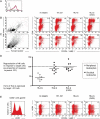Ex vivo functional responses to HLA-G differ between blood and decidual NK cells
- PMID: 21471023
- PMCID: PMC3160205
- DOI: 10.1093/molehr/gar022
Ex vivo functional responses to HLA-G differ between blood and decidual NK cells
Abstract
Restricted expression of human leucocyte antigen-G (HLA-G) to fetal extravillous trophoblast cells, which invade the decidua during implantation, suggests a role for HLA-G in placentation. In this study, we have investigated several aspects of HLA-G expression and function. Surface levels of HLA-G expression were measured in 70 normal pregnancies. We show the dimeric conformation that is unique to HLA-G forms after passage through the Golgi apparatus. Differences were found in the receptor repertoire of decidual natural killer (dNK) cells that express the leucocyte immunoglobulin-like receptor B1 (LILRB1), which binds dimeric HLA-G strongly. We then measured functional responses of dNK cells with LILRB1, when stimulated by HLA-G in both monomeric and dimeric conformations. Degranulation, interferon-γ and interleukin-8 production by dNK cells freshly isolated from the first trimester implantation site were either undetected or not affected by HLA-G. These findings should be considered when inferring the activity of tissue NK cells from results obtained with cell lines, peripheral NK or cultured dNK cells.
© The Author 2011. Published by Oxford University Press on behalf of the European Society of Human Reproduction and Embryology. All rights reserved.
Figures





Similar articles
-
A homodimeric complex of HLA-G on normal trophoblast cells modulates antigen-presenting cells via LILRB1.Eur J Immunol. 2007 Jul;37(7):1924-37. doi: 10.1002/eji.200737089. Eur J Immunol. 2007. PMID: 17549736 Free PMC article.
-
Tissue-Specific Education of Decidual NK Cells.J Immunol. 2015 Oct 1;195(7):3026-32. doi: 10.4049/jimmunol.1501229. Epub 2015 Aug 28. J Immunol. 2015. PMID: 26320253 Free PMC article.
-
Uterine NK cells and trophoblast HLA class I molecules.Am J Reprod Immunol. 1997 Jun;37(6):459-62. doi: 10.1111/j.1600-0897.1997.tb00260.x. Am J Reprod Immunol. 1997. PMID: 9228302
-
Recognition of trophoblast HLA class I molecules by decidual NK cell receptors--a review.Placenta. 2000 Mar-Apr;21 Suppl A:S81-5. doi: 10.1053/plac.1999.0520. Placenta. 2000. PMID: 10831129 Review.
-
HLA class I/NK cell receptor interaction in early human decidua basalis: possible functional consequences.Chem Immunol Allergy. 2005;89:72-83. doi: 10.1159/000087914. Chem Immunol Allergy. 2005. PMID: 16129954 Review.
Cited by
-
Natural killer cells: the immune frontline against circulating tumor cells.J Exp Clin Cancer Res. 2025 Apr 10;44(1):118. doi: 10.1186/s13046-025-03375-x. J Exp Clin Cancer Res. 2025. PMID: 40211394 Free PMC article. Review.
-
Human dNK cell function is differentially regulated by extrinsic cellular engagement and intrinsic activating receptors in first and second trimester pregnancy.Cell Mol Immunol. 2017 Feb;14(2):203-213. doi: 10.1038/cmi.2015.66. Epub 2015 Aug 17. Cell Mol Immunol. 2017. PMID: 26277900 Free PMC article.
-
Regulation of Placental Extravillous Trophoblasts by the Maternal Uterine Environment.Front Immunol. 2018 Nov 13;9:2597. doi: 10.3389/fimmu.2018.02597. eCollection 2018. Front Immunol. 2018. PMID: 30483261 Free PMC article. Review.
-
The paradox of high availability and low recognition of soluble HLA-G by LILRB1 receptor in rheumatoid arthritis patients.PLoS One. 2015 Apr 8;10(4):e0123838. doi: 10.1371/journal.pone.0123838. eCollection 2015. PLoS One. 2015. PMID: 25853899 Free PMC article.
-
Characterization and ex vivo Expansion of Human Placenta-Derived Natural Killer Cells for Cancer Immunotherapy.Front Immunol. 2013 May 1;4:101. doi: 10.3389/fimmu.2013.00101. eCollection 2013. Front Immunol. 2013. PMID: 23641243 Free PMC article.
References
-
- Apps R, Gardner L, Moffett A. A critical look at HLA-G. Trends Immunol. 2008;29:313–321. - PubMed
-
- Apps R, Murphy SP, Fernando R, Gardner L, Ahad T, Moffett A. Human leucocyte antigen (HLA) expression of primary trophoblast cells and placental cell lines, determined using single antigen beads to characterize allotype specificities of anti-HLA antibodies. Immunology. 2009;127:26–39. - PMC - PubMed
-
- Ashkar AA, Croy BA. Functions of uterine natural killer cells are mediated by interferon gamma production during murine pregnancy. Semin Immunol. 2001;13:235–241. - PubMed
-
- Banham AH, Colonna M, Cella M, Micklem KJ, Pulford K, Willis AC, Mason DY. Identification of the CD85 antigen as ILT2, an inhibitory MHC class I receptor of the immunoglobulin superfamily. J Leukoc Biol. 1999;65:841–845. - PubMed
Publication types
MeSH terms
Substances
Grants and funding
LinkOut - more resources
Full Text Sources
Other Literature Sources
Research Materials

